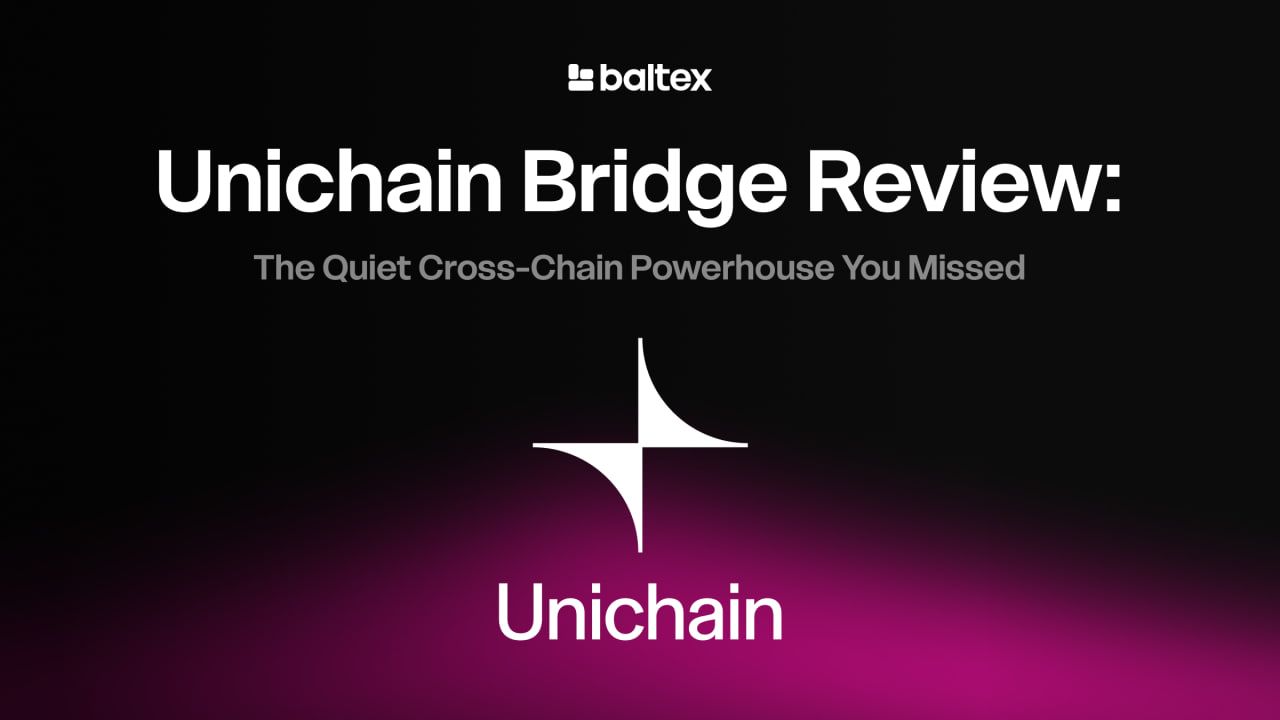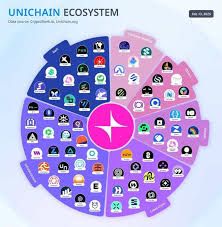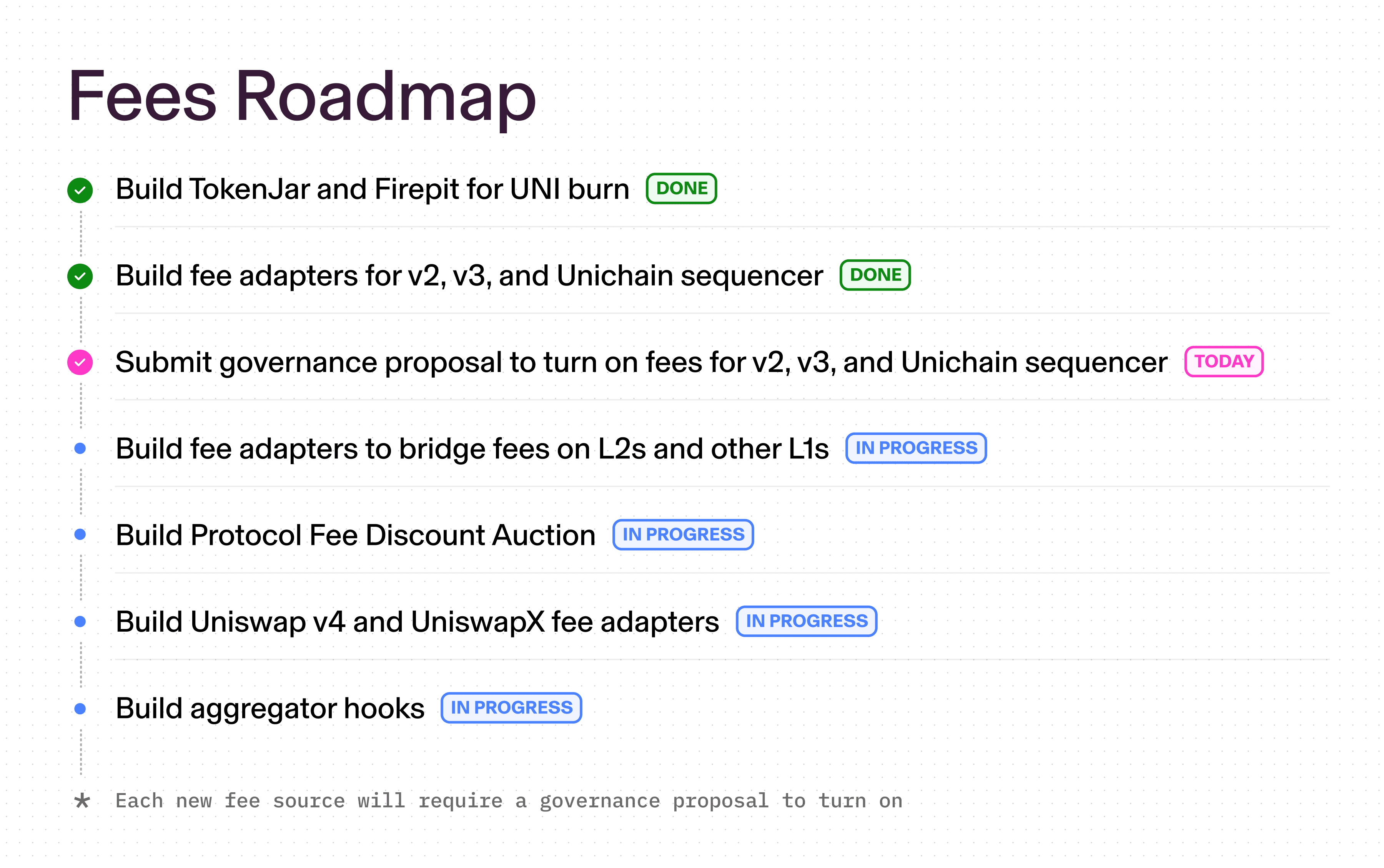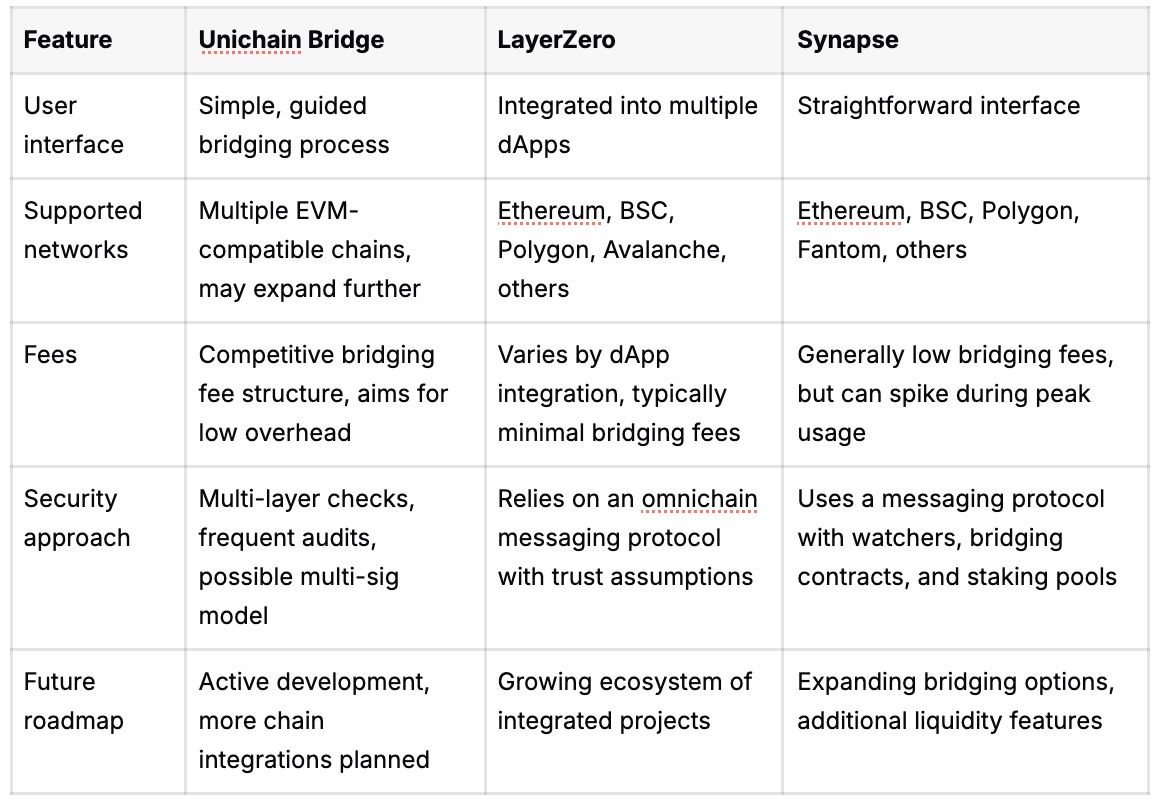
If you are looking for a hassle-free way to move digital assets across different blockchains, Unichain Bridge cross-chain could be the smart move you have been waiting for. Whether you are a seasoned DeFi user or new to crypto trading, this bridge aims to streamline your transactions and help you explore fresh opportunities without juggling multiple tools. In this guide, you will learn how Unichain Bridge works, how it stands out in 2025, and why it might just be the quiet powerhouse you missed.
Unichain Bridge is a cross-chain protocol designed to help you move tokens between distinct blockchain networks.
It focuses on minimizing fees, boosting speed, and maintaining robust security.
You can compare it to other solutions like LayerZero and Synapse, which offer similar cross-chain functionality but differ in fees, ecosystem connections, and security models.
Thanks to a user-friendly interface and plans for future enhancements, Unichain Bridge offers a practical option for traders, liquidity providers, and decentralized app (dApp) users.
Beyond bridging, you can leverage cross-chain swaps on hubs like baltex.io if you want direct trading from one chain’s token to another.
Keep reading to see how this bridge functions, what networks it supports, and why it might become a go-to service for your DeFi activities.
Unichain Bridge cross-chain is your doorway to more blockchain freedom. Rather than limit yourself to a single ecosystem, you can transact across several major blockchain networks, tapping into liquidity, yield opportunities, and features that might otherwise remain out of reach.
Crypto is not just about one chain anymore. As decentralized finance expands, you may find better staking rewards on one blockchain, faster transactions on another, and specialized DeFi apps somewhere else. A cross-chain bridge, at its core, helps you move your assets between these blockchains so you can make the most of what each network offers.
Crypto traders: If you are swapping tokens frequently, bridging could save you time and reduce the headache of maintaining multiple wallets.
DeFi liquidity providers: Adding liquidity across chains helps you tap into varied yield opportunities.
Blockchain developers: Cross-chain solutions open the doors for dApps to connect to a wider user base.
Regular users: You might just want lower fees or faster transactions. Cross-chain bridging is a neat way to access multiple networks without jumping through too many hoops.
Before diving into detailed processes, it helps to know the broad strokes of what makes Unichain Bridge tick. These features differentiate it from other cross-chain solutions and may help you decide if it is right for you.

User-friendly interface The platform aims to simplify the bridging process so you do not feel overwhelmed by technical requirements. Even if you have minimal blockchain experience, a clean interface can guide you step by step.
Broad network support Unichain Bridge connects to a variety of blockchains (detailed below), letting you transfer a wide range of tokens. This versatility is essential when you want to diversify your holdings or access multiple DeFi platforms.
Reliable security Security protocols and multi-layer checks help safeguard your assets. Given the number of bridge hacks reported in the crypto space, any cross-chain solution must place security front and center.
Competitive fees By optimizing transaction costs, Unichain Bridge appeals to everyday users who do not want bridging fees to eat into their profits.
Future-oriented roadmap With the DeFi market constantly shifting, a robust development roadmap is important. The team behind Unichain Bridge appears focused on upgrades that will keep the service relevant and user-friendly in future market conditions.
While every cross-chain protocol has its own approach, Unichain Bridge generally follows a series of steps to transfer your tokens from one chain to another. It is helpful to see the bridging process in practical terms.
When you initiate a cross-chain transfer, the token you want to move is typically locked or burned on the originating blockchain. Here is how it usually works:
Lock scenario: The protocol locks your tokens in a contract on Chain A, making them inaccessible for future use on that chain.
Burn scenario: Instead of locking tokens, the system might burn them to remove them from circulation on Chain A.

Either way, your tokens on the source chain are taken out of general circulation, so you do not accidentally double-spend them.
Next, an equivalent amount of the same token (or a wrapped version of it) appears on Chain B. This is how your assets effectively move between the two networks.
Minting: If the system locks or burns your tokens on Chain A, it mints the same number of tokens on Chain B.
Releasing: Other cross-chain solutions might hold pre-minted or pegged tokens in reserve, releasing them to you once your original tokens on the source chain are locked.
Once the transaction is validated, the newly minted or released tokens are sent to your address on the target chain. Depending on the network, this might involve confirmations or waiting for a certain number of blocks. When the final block confirmations are in, your funds become spendable on the new chain.
A big reason many traders gravitate toward Unichain Bridge is its straightforward user interface. You typically do not need to fuss over advanced settings or code anything manually. Instead, the platform guides you through selecting your source and target chains, then initiates the bridging in a few clicks.
Cross-chain bridging only matters if it connects the chains you actually use. Unichain Bridge supports a mix of established networks and emerging players, which can open up opportunities for you. Although specific chain support can evolve over time, here are the types of chains you can usually expect to see:
Ethereum: Given Ethereum’s position as the largest DeFi hub, it is often the first chain bridging solutions list.
Binance Smart Chain (BSC): Known for lower fees, making it a go-to for cost-conscious traders.
Polygon: Providing faster transactions than Ethereum, Polygon’s ecosystem is steadily growing in DeFi.
Avalanche: A popular option if you value fast finality and an expanding dApp selection.
Fantom: Leaning toward speed and scalability, Fantom is an interesting alternative for DeFi.
If you plan to move large volumes or want to explore advanced DeFi products, connecting with multiple blockchains can give you a serious advantage. New chains might also be added, so keep an eye on updates if you are looking to expand your reach.
Few things in crypto sting more than unexpected fees cutting into your profits. With Unichain Bridge, the goal is to keep costs competitive while still ensuring a reliable infrastructure. Here is what you need to know about fees:
Bridging fee This is the direct fee Unichain Bridge charges for moving assets between chains. It can be a percentage of your transaction or a flat fee, depending on the tokens and networks involved.
Transaction fees on source network When you send tokens to the step-one contract, you will pay the standard gas fees of your starting chain. For example, bridging from Ethereum may cost more in gas than bridging from a lower-fee protocol.
Transaction fees on target network After the process finishes, you will also pay gas fees on the receiving chain to confirm your transaction and move your new tokens, if you wish to relocate them.

By optimizing the bridging mechanism, Unichain aims to reduce overhead. Still, it is crucial to perform a quick cost-benefit analysis. If bridging fees, plus the transaction fees on each chain, will cut too deeply into your potential gains, you might want to wait until network congestion is lower or the bridging fee structure is more favorable for the token pair you are moving.
Security is a major talking point for any cross-chain project. Bridges are frequent targets for hackers who see cross-chain infrastructure as a high-value entry point to drain user funds. To build trust, Unichain Bridge employs several layers of protection:
Reputable blockchain auditors are often hired to inspect the code that handles locking, burning, minting, and releasing tokens. These scans aim to identify potential vulnerabilities in the smart contracts, such as reentrancy attacks or integer overflows.
The platform may distribute control of the bridging contracts across multiple participants or a network of validators, making single points of failure less likely. If any single validator attempts malicious actions, the system can block or roll back suspicious behavior.
In some cases, cross-chain providers collaborate with insurance platforms that can partially cover user funds in the event of a security breach. Monitoring tools can also alert the system to unusual transaction patterns, triggering manual reviews if something looks off.
Bridges that frequently audit and update their protocols are generally safer. It signals ongoing development, rather than a set-it-and-forget-it approach. Keeping an eye on Unichain Bridge’s development roadmap is a good way to gauge how seriously they treat security.
A complete cross-chain solution should not be viewed in isolation. Comparing Unichain Bridge with other popular options like LayerZero and Synapse can provide additional clarity.
Ecosystem integration: LayerZero often appears behind the scenes of dApps, whereas Unichain Bridge offers a more direct bridging platform for you to use. Synapse focuses on bridging and swaps but might have fewer specialized features if you want an all-in-one bridging experience.
Fee structures: Depending on the chain you are leaving or entering, bridging fees can shift. Unichain Bridge helps you pick cheaper chains if you are looking to minimize overhead, while Synapse and LayerZero rely heavily on each chain’s gas environment.
Security assumptions: Although each solution invests in security, they differ in how they manage verification. If you want a more transparent process, you could prefer a platform with well-documented audits (which Unichain aims to provide).
In the fast-paced crypto world, short-term hype is less important than a service’s ability to stay relevant. So why might Unichain Bridge become a standout choice in 2025?
DeFi is more chain-agnostic By 2025, you will probably see a lot of DeFi platforms seamlessly bridging multiple networks. Unichain Bridge might keep up by offering near-instant transfers and minimal fees across a wider range of blockchains, capitalizing on the trend toward chain-agnostic DeFi.
Rise of specialized chains As specialized application chains gain traction, bridging solutions that add them quickly could have an edge. If Unichain keeps integrating new chains, it can remain relevant by connecting users to whichever networks become hot spots for yield farming, gaming, or NFT trading.
Focus on user experience As competition intensifies, many cross-chain platforms start looking more complex. Unichain Bridge might remain strong if it retains a simple interface for both new and experienced traders.
Adoption by dApps Bridges often see higher adoption if decentralized applications integrate them directly. If more dApps choose Unichain as their default bridging option, you might find it seamlessly built into your favorite protocols, reinforcing its position in the market.
Evolving security protocols Security expectations in 2025 will be even higher than they are today. If Unichain continues to refine its security measures through audits, multi-sig approaches, and strong bug bounty incentives, it could become one of the safest bridging services available.
Moving tokens from one chain to another is just one piece of the puzzle. Often, you will want to trade them for a different token or adjust your portfolio once they arrive. That is where a cross-chain swap hub like baltex.io comes in.
Instant cross-chain swaps: Instead of bridging to a new network, then heading to a decentralized exchange (DEX) for a token swap, you can do it in fewer steps on baltex.io.
Diverse token pairs: This is handy if you need to convert a token into another that might not be available on your destination chain’s native DEX.
Synergy with Unichain Bridge: After bridging your assets via Unichain, you can quickly hop onto baltex.io to perform any final conversions. This combined workflow can save you gas fees and time.
Remember, not every trader needs advanced swaps. Some just want to hold the same token on a different chain. But if you are after more flexible portfolio management, bridging and then swapping can be a game-changer.
Unichain Bridge is straightforward, focusing on minimizing transaction complexity and offering a user-friendly approach. While many solutions compete on speed or fees, Unichain aims for a balanced mix of simplicity, security, and affordability. It may not have all the advanced features of more complex protocols, but it shines if you want a clear process and a continually updated platform.
No bridging protocol is 100 percent risk-free, but Unichain Bridge employs multiple security audits, multi-layer validations, and regular upgrades. If extra caution is your priority, you could start by sending a small test transaction to evaluate the process. Additionally, keep an eye on official announcements and documentation for ongoing security improvements.
Yes. Each blockchain has its own transaction speeds and network load, which can affect how long it takes for your tokens to appear on the destination chain. Periodically high gas fees or network congestion might slow down the bridging process. That said, Unichain Bridge aims to confirm most transactions in a relatively quick window compared to older cross-chain solutions.
To move your tokens back to the original chain, just repeat the bridging steps but in reverse. Initiate a new transaction on the destination network that locks or burns the pegged tokens, enabling the release of your original tokens on the source network. If you have tokens that only exist as a wrapped version of the original, this process should unwrap them back into the original token.
Gas fees can vary drastically. Ethereum can be expensive, especially if network activity spikes. Binance Smart Chain, Polygon, and some Layer-2 solutions typically have lower fees. Unichain Bridge itself does not control base network fees. Instead, it layers its bridging fee on top of whatever each chain requires in gas. Monitoring network activity, especially on Ethereum, can help you pick a more cost-effective time to bridge.
Yes. Unichain Bridge usually provides a transaction hash you can follow on a block explorer for the source and destination chains. This helps you see each step of the process. If there is a delay, you can quickly tell whether it is stuck at the source chain’s contract or waiting for confirmations on the target chain.
Rumors suggest the project has a roadmap that includes automated bridging for multiple token pairs at once, further chain integrations, and deeper analytics for bridging transactions. Keep an eye out for official updates to see what new features might improve your cross-chain experience.
If you need a direct swap of one token format for another after bridging, baltex.io can perform those conversions. Unichain Bridge handles the cross-chain move, while baltex.io specializes in cross-chain swaps. This way, you do not have to shuffle between multiple platforms for bridging and trading.
Unichain Bridge cross-chain is carving out its place in a fast-evolving DeFi ecosystem. If you want a balanced blend of user-friendly interface, competitive fees, and solid security practices, this bridge could be a strong contender. By 2025, as multiple specialized chains and dApps become the norm, having a reliable cross-chain option in your toolkit might be crucial.
The choice between LayerZero, Synapse, and Unichain Bridge often comes down to your personal preferences and the specific networks you frequently use. Each protocol has its own fee structure and security model, so in some scenarios, one may fit your needs better than the others.
Ultimately, the cross-chain journey is about convenience and expanding your horizons. When you no longer have to lock yourself into a single ecosystem, you can explore DeFi on your terms. And if you find yourself wanting a more direct token swap after bridging, baltex.io is ready to help you pivot quickly. By staying informed about fees, security features, and future developments, you will be equipped to navigate the cross-chain world with confidence.